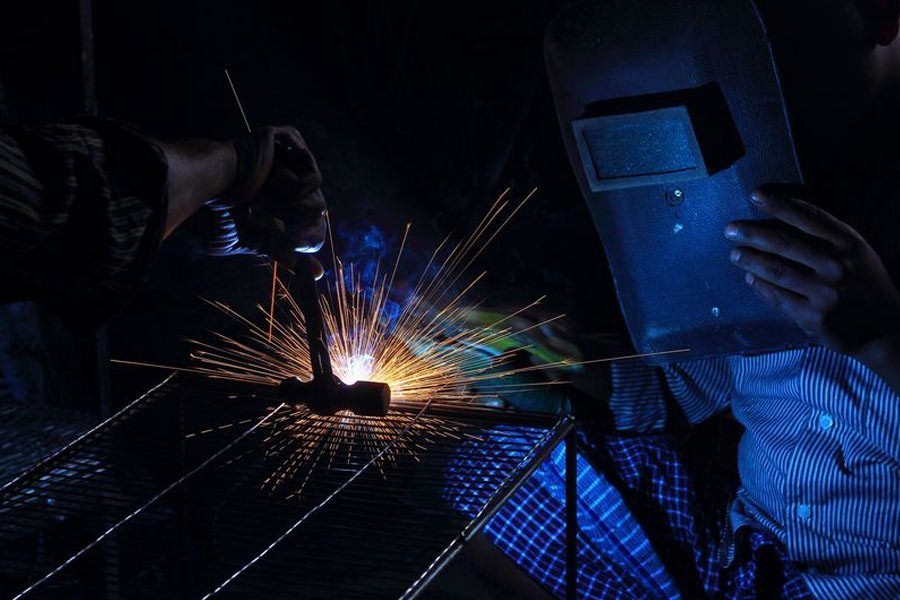The country's light engineering industry, despite its mostly informal and unregulated scope and pattern of work, is often recognised as a potential driver of economic activities that not only helps millions of small businesses to thrive but equally importantly serves as a backyard for manufacturing scores of engineering products. This has been aptly echoed by none other than the prime minister when she announced light engineering as the product of the year on the very opening day of the new year, 2020.
Light engineering is considered the mother of other industries. Over 90 per cent of these units meet domestic needs and the market size is estimated to be around Tk 600 billion, according to Bangladesh Engineering Industry Owners' Association (BEIOA). As a feeder sub-sector, light engineering produces machines, equipment, tools of heterogonous varieties for domestic usage in mills, factories and engineering workshops. Beside providing cost-cutting benefits to the consumers, its all important role is in saving foreign exchange that otherwise the country would have to spend on imports.
It is estimated that the light engineering currently accounts for around 50 per cent substitutes of imported items in the country. This is reflected in the support it provides to industrial, agricultural and construction sectors by manufacturing a wide range of spare parts, castings, moulds and dices, oil and gas pipeline fittings and light machinery, as well as repairing those. Equally significant is its role in job creation. Rough estimates suggest as many as 600,000 skilled and semi-skilled workers are employed by around 40,000 micro enterprises and 10,000 small and medium enterprises (SMES) under this sub-sector. The sub-sector is reportedly manufacturing products worth Tk 250 billion with local technology.
Despite the bright and laudable role, the downside that shrouds the sector's future to rise up to its potential is that it is yet to assume institutional shape. In order for the sector to attain institutional shape as well as growth and diversification, the key requirements are government's policy support, public-private joint initiatives for institutional and financial assistance, availability of technical and business information, innovation and up-gradation of technology, capacity building, research and development facilities and removal of a host of growth-impeding factors. A news item, published in this newspaper recently, highlighted some of the prospects as well as the immensely gifted potential of the sub-sector that could be capitalised for its growth as a major import substituting industry. Quoting experts, it said that by investing Tk 60 billion in the improvement of the light engineering sub-sector in a planned and targeted manner, it is possible for the country to save Tk 650 billion as import substitute of light engineering products every year. This also conversely implies that if the light engineering units, spread out all over the country, are not taken care of immediately to suit the varying demands of the consumers, imported products would soon seize the domestic market. The need for the sub-sector to be modernised with appropriate technology is all the more important as global competition will spare nothing to take control of niche markets.
These small and medium enterprises are currently facing serious hardships on various counts, according to the BEIOA. These include lack of advanced technology, dearth of skilled manpower, absence of product diversification and market promotion measures. Over and above, the entire industry is without any worthwhile credit finance. Industry insiders opine that bringing the innumerable work units under an integrated plan is crucially important, and to do so, a separate policy for the sector is long overdue. Government policy for the sub-sector would also facilitate adoption of work programme for product development and product adaptation for both domestic consumption and export.
It indeed appears strange that despite the enormous size of the sub-sector, it is running on its own - mostly haphazardly - without any policy direction and support. This is no doubt the reason why despite its commendable performance, it is yet to assume an institutional shape.
Although lacking in institutional shape, light engineering in the country has a solid foundation since long, aided mainly by a considerably big pool of skilled and semi-skilled workforce. While the need to train the workforce to upgrade skills is important, more important is the need for energising it by facilities for large-scale up-gradation in technology. Insiders are of the view that segmenting the sector along the types of works done might offer the opportunity for the government to look at the prospects of each of the sub-sectors as well as identify the support they need-not only policy-related, but also technological and financial and so forth. Concerned quarters believe that there is the critical need for basic infrastructural facilities like gas, electricity, water and dumping yards. This may be possible with arrangements for the units to be located in dedicated work zones in clustered forms depending on the types of works performed. So, a good deal needs to be thought out to work on a systematic plan of action to set things right for the industry to keep growing. It is in this context that the PM's announcement of light engineering as the product of the year should be seen as more than just motivational but a pressing call for appropriate policies and actions to equip the sector with the vigour and strength it so badly needs.


